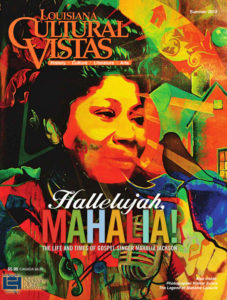About the Artist
David Johnson, who for 24 years served as Executive Editor and Art Director of Louisiana Cultural Vistas (LCV), the quarterly magazine of the Louisiana Endowment for the Humanities (LEH) and who led several other noteworthy projects including KnowLA.org: The Digital Encyclopedia of Louisiana, has departed from LEH and currently is an editorial and marketing consultant offering a wide range of services to Louisiana non-profit corporations as well as services to businesses and individuals.
Services
Writing, Editing, Art Direction, Production
Event Design: Programming, Securing Artists, Presenters
Event Management & Promotion
Marketing Strategies for Non Profits
Building Magazine Circulation & Advertising
Building & Broadening the Base of Non-Profit Membership
Design of Projects to Teach Through Art
Experience:
 Louisiana Cultural Vistas
Louisiana Cultural Vistas
David Johnson led Louisiana Cultural Vistas for 24 years. He was hired in May 1992 within the week that he graduated at the top of the magazine sequence of study from the University of Missouri School of Journalism — the first school of journalism in the world and renowned for its feet-on-the-street vocational training combined with a strong curriculum in the humanities.
While reporting for a daily city newspaper serving Central Missouri, The Columbia Missourian, Johnson developed an affinity for reporting on the cultural scene with stories that ranged from interviewing a group of amateur musicians who received a Grammy Award for their recording of old-time Ozark Mountain fiddling to a tour of the home of President Harry S. Truman, then recently acquired and opened to the public by the National Park Service.
Johnson brought his curiosity about history and culture downriver along the Mississippi and immersed himself in the ethnic milieu of Louisiana. He set about networking among Louisiana’s vast talent pool of historians, fiction writers, documentary filmmakers, poets, artists and photographers. Under the guidance of the LEH’s longtime executive director he brought the work of these often underappreciated culture bearers to the printed page in a visually impactful format. Johnson particularly prides himself on working with academics to present their research in an engaging way that draws readers far beyond the walls of academia.
Over the course of nearly a quarter century, Louisiana Cultural Vistas garnered more than 135 awards from the Press Club of New Orleans in multiple categories, from cover photography and photo essays to feature articles, critical reviews, and columns. By raising the bar high for publication, the magazine drew the likes of such luminaries as Ernest Gaines, Richard Ford, Anne Rice, Roy Blount Jr., Wynton Marsalis, William Joyce and all of Louisiana’s contemporary poets laureate as contributing writers. Long established and up-and-coming photographers were given the rare exposure of multi-page photo essays of the sort rarely seen since the demise of LIFE magazine. Prints by Michael P. Smith, Syndey Byrd, Debbie Fleming Caffrey, Philip Gould, Frank Relle, and Neil Johnson added an unparalleled photo-documentary richness to the periodical. By establishing recurring departments from partnering institutions across the state, including the Louisiana State Museum, The Historic New Orleans Collection, the Ogden Museum of Southern Art, and the Louisiana Department of Culture, Recreation, and Tourism, LCV became a clearinghouse for cultural news provided by no other media outlet in the state.
In addition to editing the magazine, Johnson’s byline has appeared numerous times in Louisiana Cultural Vistas and on its companion website, including transcribed interviews with esteemed journalist and New Orleans native Cokie Roberts and Shreveport’s Rock and Roll Hall of Famer James Burton, along with feature stories on the German-immigrant colony of Roberts Cove in Acadiana and lists of 10 “Fascinating Facts” about such subjects as the Civil War in Louisiana and the long-running country music radio hoedown known as the Louisiana Hayride.
Experience: The KnowLa Project
In 2007 the LEH launched an ambitious digital project known as KnowLA:
The Digital Encyclopedia of Louisiana (knowla.org). Scholars from across the state and nation were assigned to write encyclopedic entries on a range of subjects related to the state, from biographical sketches of politicians, musicians, artists, writers, military figures and athletes to the cultural symbols that define Louisiana: gumbo, zydeco music, jazz, Catahoula dogs, the concept of “lagniappe,” and even drive-through daiquiri stands. Following the departure of the founding editor in 2010, Johnson was tapped to lead the project and supervised a staff of five assistant editors who collectively uploaded more than 1,000 entries, all of which he edited, and 4,000 related media (photographs, film, and interactive) to the website that has drawn a worldwide audience of more than one million viewers per year. Though relatively small in size, Louisiana looms large in the global imagination and KnowLA provides a factual and free online resource for anyone seeking information about all that makes the state a unique cultural wellspring.
History of Art in Louisiana
In 2012, in celebration of the 200th anniversary of Louisiana’s admission to the Union as the 18th state, the LEH published a landmark coffee-table book, A Unique Slant of Light: The Bicentennial History of Art in Louisiana. Johnson led the effort to enlist art historians who were commissioned to write brief biographies of more than 280 artists from the French-colonial era to present day. Each entry was accompanied by one representative artwork by the selected artist for the book. Longer essays on such topics as decorative arts, Mardi Gras-themed art, folk art and Native American basketry were also added as separate chapters. The resulting lavishly illustrated 400-page publication was then digitized in a flip-page format and uploaded to the KnowLA website as a study tool. By clicking on the page representing one artist, web visitors are guided to a more thorough biography of the individual and a larger gallery of images.
Experience:
Broadening Bases of Support
Johnson pursued many avenues to broaden Louisiana Cultural Vistas’ subscription base. Partnering institutions provided the magazine their mailing lists so that the broadest audience of Louisianans who have expressed an interest in cultural journalism could be reached with a sample complimentary issue. The LEH also purchased mail lists for in-state subscribers to Smithsonian, National Geographic, and Conde Nast Traveler, among other magazines of similar content focus. Copies were brought to major humanities-based festivals including the Tennessee Williams/New Orleans Literary Festival, the Louisiana Book Festival, and the Louisiana Folk Festival, to increase exposure. State and federal (NEH) funding largely paid LCV’s print costs for nearly 20 years, but as taxpayer allocations tightened and the LEH was zeroed out of the budget for higher education and tourism, the magazine began to aggressively pursue advertising. Thus far, the magazine has drawn major corporate support from Shell, BP, Entergy, and Air Liquide. These Fortune 500 companies view the magazine as an asset in luring business to the state. Individual ads have been purchased by restaurants, boutiques, hotels and museums largely based in New Orleans. LCV is distributed in more than a dozen hotels in New Orleans’ CBD and French Quarter as a cultural guide for tourists. Complimentary copies are also distributed at each of the state-funded visitors centers located across Louisiana, from interstate rest stops at the state’s boundaries to a site at Jackson Square in the heart of the Vieux Carré.
In an effort to connect the contributors of content in Louisiana Cultural Vistas with paying and potential subscribers, Johnson organized quarterly publication parties and other speakers events at the Louisiana Humanities Center, the LEH’s historic headquarters in New Orleans’ Central Business District. Two to three authors or photographers are invited to speak upon the debut of each issue. Speakers have included:
- The PR director for Angola State Prison who spoke about a unique historic preservation project at the penitentiary where inmates restored the original cellblock building.
- Captain Clarke “Doc” Hawley, a 50-year veteran of working aboard Mississippi River passingr boats. He demonstrated the skill needed to play the calliope aboard the Steamboat Natchez.
- Authors Sally Asher and Carolyn Morrow Long who spoke about fascinating but macabre historical moments in New Orleans’ past on a date near Halloween/All Saints Day. Asher spoke about the shipwreck of the Evening Star, a tragedy that drowned renowned architect James Gallier Sr. and an unrelated large number of prostitutes who were bound for the Crescent City in 1866. Long spoke about her research on all of the documented bodies buried within the famous tomb of Voodoo priestess Marie Laveau.
- Four historians who spoke about the highly contentious issue of Confederate monuments in New Orleans as debate raged in City Hall and in the public square over their fate. Johnson moderated a panel discussion that garnered positive press for the LEH’s brave willingness to offer a scholarly forum on such a heated topic.
Johnson currently serves on the board of the Tennessee Williams/New Orleans Literary Festival where he serves as literary liaison. He recruits numerous authors and actors to join in panel discussions and interviews. In 2016 he secured former child actress Mary Badham (“Scout” from the 1962 movie To Kill A Mockingbird) as the keynote speaker for the opening gala. He has interviewed Pulitzer Prize-winner Rick Bragg twice and led discussions on such topics as the Mississippi River as literary inspiration, the history of the Carville leprosarium, independent publishing, and the craft of writing biographies. Johnson has previously served on the boards of YAYA: Young Artists/Young Aspirations, the World Affairs Council of New Orleans, and the Press Club of New Orleans.
